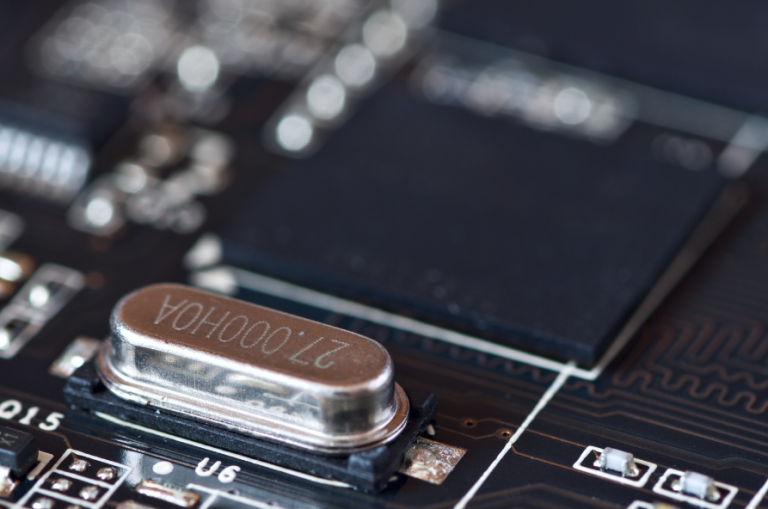What is an Oscillator? Functionality, Performance and Applications

More from the Category
Oscillators are essential components in the world of electronics, playing a crucial role in generating periodic signals. From the simplest applications to complex systems, oscillators provide the timing signals needed for synchronization and control. This article explains what oscillators are and how they work, explores the various types and their performance characteristics, highlights their applications across industries, and reviews recent advancements in this essential technology.
What is an Oscillator?
An oscillator is an electronic circuit that produces a continuous, periodic signal — typically in the form of a sine wave, square wave, or triangle wave — without requiring an input signal. These signals are defined by their frequency and amplitude, which can be precisely controlled to suit specific applications. In essence, an oscillator converts energy from a DC power supply into an AC signal.
Oscillators are found in a wide array of devices, including clocks, radios, and computers. They are considered the heartbeat of electronic systems, serving as timing references that enable circuits to synchronize and function properly.
What is an Oscillator in a CPU?
A CPU oscillator is responsible for generating clock signals that regulate the timing and speed of the processor. These clock signals synchronize various CPU components, allowing for the coordinated execution of instructions.
Typically, a crystal oscillator is used, which relies on the mechanical resonance of a vibrating quartz crystal to produce a stable frequency. This precise timing is critical to a CPU’s performance and efficiency, as it directly affects the instruction execution rate.
How Do Oscillators Work?
Oscillators operate based on the principles of feedback and resonance. The basic components of an oscillator include:
• Amplifier: Boosts the signal.
• Feedback network: Determines the frequency of oscillation.
• Energy source: Supplies power to sustain the oscillation.
The system continuously feeds part of its output back to the input, allowing the signal to regenerate itself. The frequency of oscillation depends on the configuration of components such as resistors, capacitors, and inductors within the feedback loop.
Purpose of an Oscillator
The primary purpose of an oscillator is to generate consistent clock signals that control the timing and synchronization of electronic systems, especially CPUs. These signals are essential for ensuring the coordinated execution of instructions, which in turn impacts overall system performance.
Types of Oscillators

Oscillators are generally divided into two main categories:
• Relaxation Oscillators: Produce non-sinusoidal waveforms such as sawtooth or square waves.
• Linear Oscillators: Generate sinusoidal waveforms.
Within these categories, several specific types of oscillators are commonly used:
Crystal Oscillators: Use quartz crystals to generate precise frequencies. Known for their stability and accuracy, they are ideal for communication devices and clocks.
RC Oscillators: Utilize resistors and capacitors to generate sine or square waves. Often used in audio applications due to their simplicity and cost-effectiveness.
LC Oscillators: Use inductors (L) and capacitors (C) to produce oscillations. Typically employed in radio frequency (RF) applications due to their high-frequency capability.
Phase-Locked Loop (PLL) Oscillators: Used for frequency synthesis and modulation. Essential in telecommunications for signal processing and frequency control.
Emerging Oscillator Technologies
Recent advancements in oscillator technology focus on performance improvement, miniaturization, and integration with other electronic components.
• MEMS Oscillators: Microelectromechanical systems offer smaller form factors, highly stable reference frequencies, and low power consumption — ideal for portable devices.
• Programmable Oscillators: Allow for customized frequency outputs, reducing component count and streamlining the design process.
Devices That Use Oscillators
Many electronic devices rely on oscillators for essential functions like timing, signal generation, and frequency control. Examples include:
• Quartz Watches
• Radios
• Computers
• Cellphones
• Radar Systems
• Metal Detectors
Performance Characteristics of Oscillators
Oscillator performance is measured by several key characteristics:
• Frequency Stability: The ability to maintain frequency over time and environmental changes. Crystal oscillators are especially valued for their high stability.
• Phase Noise: Measures short-term frequency fluctuations. Lower phase noise is crucial in high-performance communication systems.
• Waveform Shape: The output waveform (sine, square, etc.) must match application requirements for optimal performance.
Are Oscillators Active Components?
Yes, oscillators are classified as active components. They amplify electrical signals and generate power, distinguishing them from passive components like resistors and capacitors. While oscillators incorporate passive elements in their circuits, their role in signal generation qualifies them as active devices.
Industries That Use Oscillators
Telecommunications
Oscillators generate carrier signals for data transmission. Their stability and accuracy ensure signal integrity over long distances. Crystal and PLL oscillators are widely used here.
Consumer Electronics
Devices like smartphones and TVs rely on oscillators to generate clock signals for microcontrollers. Their precision directly impacts device performance.
Automotive
Used in engine control units, infotainment systems, and sensor applications (e.g., ABS), oscillators regulate timing for ignition and fuel injection.
Medical Devices
Essential in pacemakers and diagnostic tools, where reliability and precision are critical. Crystal oscillators are often chosen for their long-term stability.
Partner with Us
Understanding oscillators and their functions is essential for anyone working with electronic systems. They provide the timing signals that drive everything from processors to communication systems. With ongoing advancements such as MEMS and programmable oscillators, this technology continues to evolve — shaping the future of electronic design and innovation.
At Microchip USA, we’re here to help you source the right oscillator for your next project. With tens of millions of components supplied across various industries and a team of experts ready to assist, we’re your go-to partner for reliable component sourcing. Contact us today!


